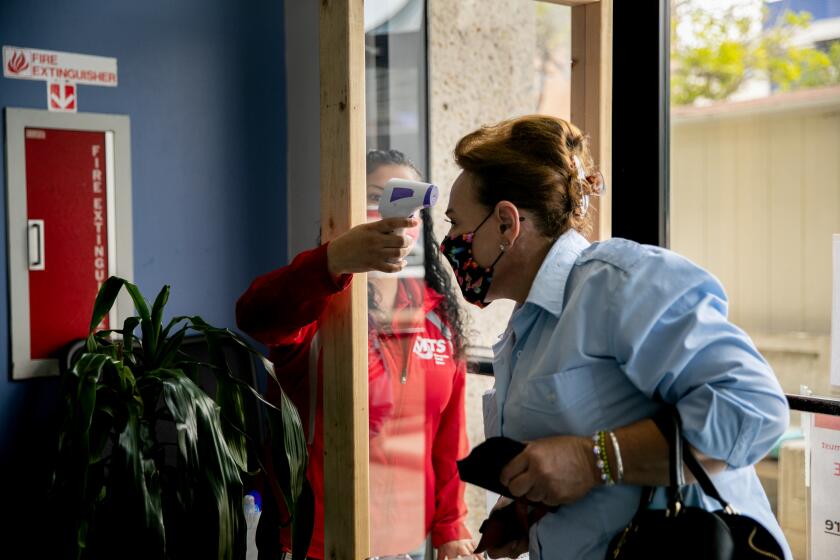COBRA is free for six months under the COVID relief bill. Do you qualify?
- Share via
Americans who lost a job in the last 18 months are able to stay on or join their former employer’s healthcare plan for free through Sept. 30. That provision of the American Rescue Plan Act went into effect April 1.
More than 2 million people could benefit, according to the Congressional Budget Office.
The way it works is through the federally administered program known as COBRA. If you work at a company with more than 20 employees and lose your job, you can remain on your employer-sponsored health insurance plan for 18 months through COBRA.
Here’s what workers are now entitled to under the 2021 COVID-19 Supplemental Paid Sick Leave requirement — and what employers’ obligations are.
But under normal circumstances, COBRA can be significantly more expensive than employer-sponsored insurance because instead of your employer covering some of the premium, you pick up the entire tab. COBRA costs include the premium of your plan plus a 2% administrative charge, meaning that this year you could have been looking at monthly outlays of $635 if you’re single or $1,800 for a family, said Thomas Rice, professor of health policy and management at the UCLA Fielding School of Public Health.
But COBRA is now free through the end of September. Here’s what you need to know.
Who qualifies?
Qualifying criteria for COBRA include any of the following: “job loss, reduction in the hours worked, transition between jobs, death, divorce and other life events,” according to the U.S. Department of Labor.
Under the relief bill, anyone is eligible who has involuntarily lost their job or health insurance or had their hours reduced within the last 18 months. A reduction in hours covers the business’ change in hours of operations, a shift from full-time to part-time status, if you take a temporary leave of absence or if you participated in a lawful labor strike.
Benefits are available to all those normally insurable under COBRA, meaning you and the family members who were already on your health plan.
The California Policy Lab says a stimulus gap may be between 2.2 million Californians and payments that are owed to them. Up to $5.7 billion may be unclaimed. To get your share, you probably need to file a tax return.
Who doesn’t qualify?
Anyone who voluntarily left their job or chose to reduce their work hours, with some exceptions. Also, if you were fired for gross misconduct, you and your dependents are not eligible for COBRA.
If you already have health insurance, whether through the government or your employer, you are not eligible to enroll in subsidized COBRA.
Also, beneficiaries who recently turned 26 (the cutoff age for dependents to stay on their parents’ health insurance) and former spouses who lost their coverage due to a divorce will be unable to receive free COBRA benefits but can expect lower costs “on Marketplace health insurance coverage thanks to provisions in the American Rescue Plan Act of 2021,” according to the Labor Department.
How to enroll in COBRA
In general, employers have 60 days to notify you of your COBRA eligibility.
If you are newly eligible under the relief bill, your employer is required to notify you by May 31, said Grant Vaught, a Labor Department spokesperson. If your employer or the employment-based group health plan you were a part of do not notify you, the Labor Department recommends contacting your employer to request information on your eligibility.
If your employer waits until the May 31 deadline to notify you, you could miss out on two months of free coverage. So UCLA’s Rice said you should contact your former employer as soon as possible to avoid losing out on benefits. If you’re not in a rush, you have until July 30 to enroll.
For those already enrolled in a COBRA plan, subsidized premiums were set to begin April 1 and end Sept. 30. The provision does not extend your policy’s life beyond the normal 18 months, though.
In California, if your employer has two to 19 employees, you may be covered by Cal-COBRA. Cal-COBRA may also be able to extend your coverage if your federal COBRA plan has expired. For more information, go to the state’s Department of Managed Health Care website.
What else should you know?
Although the subsidy covers the health plan’s premium, you will still be responsible for copays and deductibles.
If you sign up for subsidized COBRA, you can keep it past Sept. 30, but you will have to pay the premiums after that date. After the subsidization period ends, you may become eligible for Medicaid or coverage through the Health Insurance Marketplace, according to the Labor Department.
Coverage under subsidized COBRA is not retroactive. If you were insured through COBRA before April 1, medical and premium costs incurred before then are not refundable, according to the Labor Department.
If at any point between April 1 and Sept. 30 you pay in full for COBRA but were eligible for free coverage, you may qualify for a refund or credit. Contact the plan administrator or the employer sponsoring the plan.
Other options
If you don’t qualify for or can’t afford COBRA, you may have other options.
- Plans on the Affordable Care Act marketplace may be less expensive than COBRA. healthcare.gov; (800) 318-2596.
- California residents can use Covered California, the state’s Affordable Care Act marketplace. coveredca.com; (800) 300-1506.
- Insurance benefits just for children may be available. insurekidsnow.gov; (877) 543-7669.
More to Read
Inside the business of entertainment
The Wide Shot brings you news, analysis and insights on everything from streaming wars to production — and what it all means for the future.
You may occasionally receive promotional content from the Los Angeles Times.













